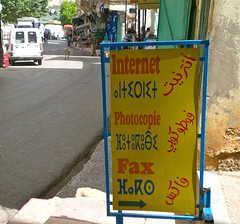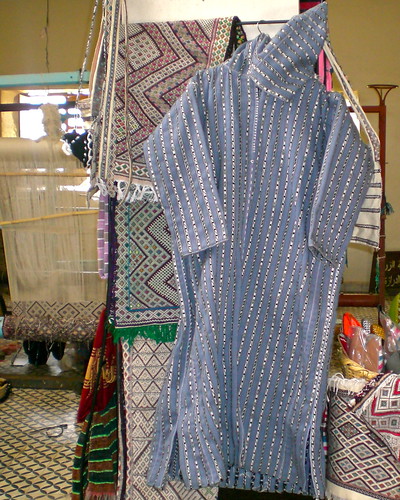Unlike the large Arab cities of Fez, Rabat and Casablanca, Ain Leuh is considered a Berber, or Amazigh village. The Amazigh people have populated North Africa for centuries – the textbooks say 1500BC – and historically have wandered the landscape in nomadic or semi-nomadic tribes. These tribes generally avoided urban centers, and even today most Amazigh people inhabit the rural countryside, or small villages like Ain Leuh.
Because tribes avoided central power, cultural exchange was limited throughout the centuries. There still exists much diversity among the Amazigh people today. The indigenous language spoken in Ain Leuh is called Tamazight, whereas in the south, Tashalhiet is spoken. Likewise, Amazigh weavings differ in technique, appearance, pattern, and typical colors even within the Middle Atlas region.
In and around Ain Leuh, weavings were made for functional purposes, and made only by women. The weavings here are flat-weave and rarely pile carpets, which are more functional in the colder winters of the High Atlas Mountains of the south. These flat-weaves were used as sleeping mats, covers against the cold, door coverings, or turned into clothing, like a jellaba (cloak) or handira (shawl). It was only during the French protectorate that weavings were produced to be sold.
Before the introduction of Islam to the region, the Amazigh were animistic, that is, they believed humans, animals, plants, mountains and other geographical features contained souls or spirits. Weavings were an outlet for a woman’s spiritual and artistic expression, and patterns relating to protection and fertility evoked these animistic beliefs. Although much of the original meaning has been lost with many of today’s weavers, they still use many of the same motifs their ancestors used. In some cases these motifs have taken on new meanings.
Amazigh identity in Morocco is a complex issue that scholars have devoted their lives to studying. What it means to be “Amazigh” varies widely from region to region, depending on economic status, education level, gender, and many other factors. For example, a friend of mine traveled to the south last year and met a well-educated Amazigh man who would only speak to him in Tashelheit or French, never in Arabic, because he considered the Arabs the true colonizers of North Africa.
I have experienced quite the opposite here in Ain Leuh. The women I work with are all “arabized”. That is, only Arabic is spoken in the house, despite the fact that most of the women speak Tamazight, and all women consider themselves Muslim. Khadija, for example, was brought up speaking Tamazight as a child, but her children only speak Arabic. One woman my age, whose mother was Amazigh, said with pride that she could understand not a word of Tamazight.
Some women have expressed embarrassment at their Amazigh heritage. Among the oldest generation only, it is typical to see women with thin linear and geometric tattoos on their chins, foreheads, hands, even jaw lines and ankles. The tattoos are an indication of marital status, or simply to enhance a women’s beauty. When I asked Mehma, a cooperative member about her tattoos, she explained apologetically that it was a tradition carried out before everyone knew tattoos were forbidden (according to the Quran).
The cooperative is perhaps the only place I’ve heard the women speaking in Tamazight. Jamila, one of the younger members of the cooperative, showed me how dried pomegranate rinds are crushed into a powder to be used later as a yellow wool dye. She made sure I knew that this was a technique invented by rural women generations ago. To me, it seems like the one place where the women can express pride in their Amazigh heritage is at the loom.
Posted By Laura McAdams
Posted Jul 6th, 2012



